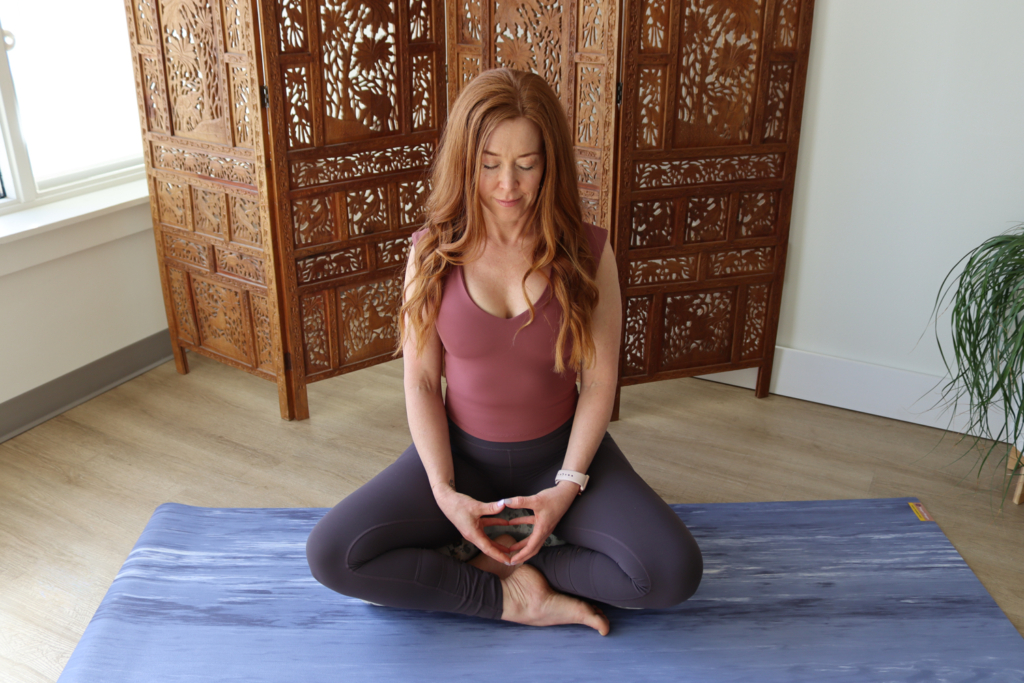This entry was posted on Could 20, 2025 by Charlotte Bell.

There’s energy in your palms, greater than you may assume. I used to be first uncovered at hand mudras throughout iRest (Yoga Nidra) coaching with Richard Miller, PhD, many years in the past. Whereas I knew our palms are extremely enervated, and command plenty of actual property within the mind’s physique maps, I had no thought how simply completely different hand positions translated to results in the remainder of the physique. In Miller’s coaching, I discovered mudras for pranayama, meditation, and positions supposed to “gentle up” every chakra. Nevertheless, we didn’t follow Hakini Mudra.
Typically known as “Mind Energy Mudra” or “Mudra for the Thoughts,” Hakini Mudra is claimed to reinforce mind energy. In keeping with the yoga custom, practising this mudra improves focus, reminiscence and focus. I discovered Hakini Mudra from yoga instructor Jenny Otto, as a place that may give us entry to completely different areas of our “respiration area.”
Why Broaden Your Respiratory House?
In keeping with an article in Therapeutic massage & Bodywork Journal, “The Science of Mouth vs. Nostril Respiratory” by John Douillard, the ribcage turns into a literal cage for our lungs and diaphragm over time. Extreme sitting, shallow respiration and sedentary existence all contribute to this drawback. When the ribcage turns into inflexible, the diaphragm can now not totally contract once we inhale. Consequently, our respiration turns into shallower.
Right here’s how Douillard explains it:
”When the diaphragm contracts, it attracts oxygen into the lungs, forcing the ribcage to develop. Over time, because the ribcage turns into extra rigicl, the diaphragm weakens and can’t totally contract on inhalation and chill out on exhalation. This implies the breath sample turns into shallow. Through the years, we’re prone to develop into shallow breathers, partaking in what is known as over respiration.
“Throughout shallow respiration, 75 % of the oxygen we inhale is exhaled unused. Shallow respiration additionally forces us to breathe out extreme carbon dioxide. On this shallow respiration state, the oxygen ranges within the blood keep excessive whereas CO2 ranges plummet. That is the right storm for anxiousness, which is why when of us have a panic assault, they attempt to increase carbon dioxide ranges by respiration right into a paper bag. Whereas persistent blood ranges of extra oxygen and low-carbon dioxide enhance the physique’s srress response, rising blood ranges of carbon dioxide even have a sedation impact on the physique.“
I extremely advocate you learn the complete article (linked above). It offers very important details about the significance of diaphragmatic respiration. It’s a should for yoga academics!
Tips on how to Follow Hakini Mudra to Broaden the Breath
Hakini Mudra may give us entry to the decrease, center and higher respiration areas, just by how we contact our fingertips.
- Start by discovering a snug seated place. Be sure you have sufficient help beneath your hips in order that your backbone can relaxation in its pure curves. Right here’s an article with options for figuring out the very best meditation cushion to your physique. You may also follow in a chair if sitting on the ground doesn’t work to your physique.
- Place your fingertips collectively. Contact flippantly; be sure that your fingers aren’t urgent onerous. On the similar time, your fingers ought to join solidly—not too onerous, not too tender.
- Take 5 or extra deep breaths, adjusting your posture to accommodate deep respiration. Make sure that your ribcage and stomach are increasing outward as you inhale, and contracting inward as you exhale. Inhale totally, however with out pressure. Exhale utterly, with out pressure.
- Now press your pinky and ring fingers collectively barely extra firmly than the opposite fingers. Proceed to breathe, and see the place you’re feeling the “heart” of your breath inside your torso. Take 5 to 10 deep breaths.
- Let go of the pinky and ring fingers, touching them flippantly once more. Then press the center fingers collectively barely extra firmly than the others. Take 5 to 10 deep breaths, noticing the place you’re feeling the middle of your breath.
- Let go of the center fingers, touching them flippantly once more. No press the thumbs and index fingers collectively a bit extra firmly than the others. Take 5 to 10 deep breaths, noticing the place you’re feeling the middle of the breath.
- Now contact the fingers evenly, flippantly, and take a couple of extra breaths earlier than returning to common respiration.
When you’re practising, be at liberty to modify backwards and forwards between steps 4-6 that can assist you really feel variations in how the finger contact influences your respiration. Follow this any time to assist maintain your ribcage and diaphragm supple, and your breath free and simple.
About Charlotte Bell
Charlotte Bell found yoga in 1982 and commenced instructing in 1986. Charlotte is the writer of Aware Yoga, Aware Life: A Information for On a regular basis Follow and Yoga for Meditators, each revealed by Rodmell Press. Her third ebook is titled Hip-Wholesome Asana: The Yoga Practitioner’s Information to Defending the Hips and Avoiding SI Joint Ache (Shambhala Publications). She writes a month-to-month column for CATALYST Journal and serves as editor for Yoga U On-line. Charlotte is a founding board member for GreenTREE Yoga, a non-profit that brings yoga to underserved populations. A lifelong musician, Charlotte performs oboe and English horn within the Salt Lake Symphony and people sextet Purple Rock Rondo, whose DVD received two Emmy awards.

